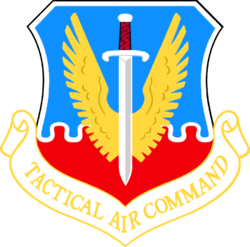474th Tactical Fighter Wing
474th Tactical Fighter Wing
 | |
|---|---|
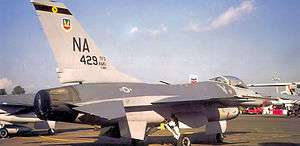 | |
| Active | 1952–1954; 1957–1989 |
| Country | United States |
| Branch |
|
| Role | Fighter |
| Engagements |
Korean War Vietnam War[1] |
| Decorations |
Air Force Outstanding Unit Award with Combat "V" Device Air Force Outstanding Unit Award Republic of Korea Presidential Unit Citation Vietnamese Gallantry Cross with Palm[1] |
| Commanders | |
| Notable commanders |
James B. Davis Chuck Horner |
| Insignia | |
| Patch with 474th Tactical Fighter Wing emblem (approved 14 November 1958)[1] |
 |
The 474th Tactical Fighter Wing is an inactive United States Air Force unit. Its last assignment was at Nellis Air Force Base, Nevada, where it trained combat-ready aircrews and maintained a rapid-reaction capability to execute fighter attacks against enemy forces and facilities in time of crisis. During its operational lifetime, the 474th was engaged in combat operations during the Korean and Vietnam Wars. The 474th TFW was inactivated on 30 September 1989.
History
The '474th' numbering of the Wing pays tribute to the 474th Fighter Group, originally constituted on 26 May 1943, and activated on 1 August 1943 at Glendale, California. For the next several months the group trained for combat with P-38's. Moved to England, February–March 1944 where it was assigned to Ninth Air Force.
Korean War
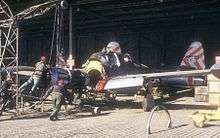
The 474th Fighter-Bomber Wing was activated in Japan in 1952. It was moved the same day to South Korea with tactical components to begin Korean War combat operations. Tactical components were detached on 1 April 1953, while the rest of the wing reduced to "paper" status, a condition which prevailed until the wing inactivated in 1954.
Tactical fighter operations
Activated in the United States in October 1957 and until mid-September 1964 maintained proficiency in tactical fighter operations, deploying components, aircraft, and crews on a global basis in support of NATO, PACAF, Alaskan Air Command, and other organizations. Deployed three squadrons to southeastern United States during the Cuban Missile Crisis of 1962. The entire wing, except for a deployed squadron in Southeast Asia, reverted to "paper" status on 15 September 1965, the single detached squadron being reduced to "paper" status upon its return to the United States.
On 20 January 1968 the wing moved to Nellis Air Force Base, Nevada,[2] giving the base an operational tactical fighter wing, assigned to Twelfth Air Force. With the move to Nellis, the 474th Combat Support Group became the base operating host unit.[2]
F-111 operations
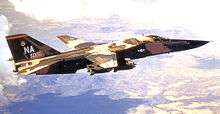
The 474th became the first USAF operational wing equipped with the General Dynamics F-111.[3] In early 1968, the Air Force decided to rush a small detachment of F-111As to Southeast Asia under a program known as "Combat Lancer". Six 428th Tactical Fighter Squadron F-111As were allocated to the Combat Lancer program, and departed Nellis for Takhli Royal Thai Air Force Base on 15 March 1968. By the end of that month, 55 night missions had been flown against targets in North Vietnam, but two aircraft had been lost. 66–0022 had been lost on 28 March, and 66-0017 on 30 March. Replacement aircraft had left Nellis, but the loss of a third F-111A (66-0024) on 22 April halted F-111A combat operations. However, the aircraft remained poised for combat, but they saw little action before their return to the USA in November.[3]
It turned out that the three F-111A losses were not due to enemy action but were caused by wing and tail structural defects. One of the Combat Lancer crashes had been traced to a malfunction of the aircraft's tail servo actuator. These losses caused a storm of controversy in the United States, with Wisconsin Senator William Proxmire denouncing the F-111A as an unsafe and defective plane. However, the Air Force and General Dynamics remained hard at work trying to fix the problems with the F-111A. The 428th TFS of the 474th TFW reached an initial operational capability in the spring of 1968. Modifications to the F-111 took a lot longer than expected, and the Wing was not fully operational until July 1971.[3] In December 1968, Tactical Air Command activated the 4527th Combat Crew Training Squadron (Tail Code "ND") as a dedicated F-111 pilot training squadron at Nellis. The provisional squadron performed lead-in training for experienced pilots in the F-111, it was replace in October 1969, transferring its personnel and equipment to the newly activated 442d Tactical Fighter Training Squadron.[4]
The 474th returned to Takhli in September 1972. Three F-111A squadrons (the 428th, 429th and 430th) participated in the Operation Linebacker II bombing offensive against North Vietnam. They flew bombing missions against targets in North Vietnam and Laos in the midst of the monsoon season. They flew without RB-66E electronic countermeasures escort aircraft or Boeing KC-135 Stratotankers. On 8 November 1972, they flew 20 strikes over North Vietnam in weather that grounded other aircraft. Four F-111As could deliver the bomb loads of 20 F-4s. The 428th, 429th and 430th TFS flew some 4000 combat missions with excellent success rates in hitting targets even when visibility was near zero. Only six aircraft were lost in action.[3]
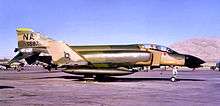
The 430th TFS returned to the 474th TFW Nellis on 22 March 1973 assuming a replacement training unit mission, while the 428th and 429th were assigned to the newly transferred 347th Tactical Fighter Wing at Mountain Home Air Force Base, Idaho on 30 July 1973. With the end of hostilities in Southeast Asia, the 474th's mission was to train combat-ready force of aircrews and maintained a rapid-reaction capability to execute fighter attacks against enemy forces and facilities in time of crisis.[3]
In 1975, the 428th and 429th were reassigned to the wing, again being equipped with F-111As. In August 1977, the F-111 aircraft and crews were transferred to Mountain Home AFB, Idaho, and the 474th Wing absorbed the McDonnell F-4 Phantom II aircraft, crews, and resources of the inactivating provisional 4474th Tactical Fighter Wing at Nellis in April 1977, as part of "Operation Ready Switch".[2] The Phantoms had a relatively short life, being replaced with new General Dynamics F-16A Fighting Falcons. The 474th was the third USAF wing to receive Fighting Falcons. It received its first Block 1/5 F-16A/Bs in November 1980, later operated Block 10 F-16A/Bs.[3][5]
F-16 operations
The wing conducted routine Tactical Air Command training and deployments from Nellis with the F-16s, retaining the Block 10/15 models until September 1989, when the wing was inactivated, the F-16As no longer being considered as front-line aircraft. Instead of re-equipping the wing, the F-16As were transferred to Air National Guard and Air Force Reserve squadrons, and the three squadrons resurfacing as General Dynamics-Grumman EF-111A Raven Electronic Warfare Squadrons with the 27th Operations Group (27th Tactical Fighter Wing) at Cannon Air Force Base, New Mexico.[2]
Lineage
- Established as the 474th Fighter-Bomber Wing on 25 June 1952
- Activated on 10 July 1952
- Inactivated on 8 November 1954
- Activated on 8 October 1957
- Redesignated 474th Tactical Fighter Wing on 1 July 1958[6]
- Inactivated on 30 September 1989
Assignments
- Tactical Air Command, 10 July 1952 – 8 November 1954 (attached to Fifth Air Force until 1 April 1953, then to 58th Fighter-Bomber Wing)
- 832d Air Division, 8 October 1957
- USAF Tactical Fighter Weapons Center, 20 January 1968
- 832d Air Division, 20 March 1968 (attached to Seventh Air Force, Advanced Echelon (ADVON), c. 27 September 1972—c. 23 March 1973)
- Twelfth Air Force, 1 July 1975 – 30 September 1989[6]
Components
- 474th Fighter-Bomber Group: 10 July 1952 – 8 November 1954
- 428th Tactical Fighter Squadron: 8 October 1957 – 30 July 1973; 15 June 1975 – 30 September 1989
- 429th Tactical Fighter Squadron: 8 October 1957 – 30 July 1973; 21 June 1975 – 30 September 1989
- 430th Tactical Fighter Squadron: 8 October 1957 – 15 November 1966; 15 September 1968 – 30 September 1989
- 442d Tactical Fighter Training Squadron: 15 October 1969 – 31 July 1977
- 478th Tactical Fighter Squadron: 8 October 1957 – 1 November 1966
- 4474th Tactical Training Squadron: 1 December 1968 – 15 June 1970 (not operational)
- 4527th Combat Crew Training Squadron: 20 January 1968 – 15 October 1969
Stations
- Misawa Air Base, Japan, 10 July 1952
- Kunsan Air Base (K-8), South Korea, 10 July 1952
- Taegu Air Base (K-2), South Korea, 1 April 1953 – 8 November 1954
- Cannon Air Force Base, New Mexico, 8 October 1957
- Nellis Air Force Base, Nevada, 20 January 1968 – 15 October 1989[6]
Aircraft
- Republic F-84 Thunderjet, 1952–1953
- F-100 Super Sabre, 1957–1965
- General Dynamics F-111A, 1968–1977[6]
- McDonnell F-4D Phantom II, 1977–1981
- General Dynamics F-16 Fighting Falcon, 1981–1989
References
- Notes
- Citations
Bibliography
![]()
- Futrell, Robert F. (1983). The United States Air Forces in Korea 1950–1953 (PDF). Washington, DC: Office of Air Force History. ISBN 0-912799-71-4. Retrieved 17 December 2016.
- Martin, Patrick (1994). Tail Code: The Complete History of USAF Tactical Aircraft Tail Code Markings. Atglen, PA: Schiffer Military Aviation History. ISBN 0-88740-513-4.
- Mueller, Robert (1989). Air Force Bases, Vol. I, Active Air Force Bases Within the United States of America on 17 September 1982 (PDF). Washington, DC: Office of Air Force History. ISBN 0-912799-53-6. Retrieved 17 December 2016.
- Ravenstein, Charles A. (1984). Air Force Combat Wings, Lineage & Honors Histories 1947–1977 (PDF). Washington, DC: Office of Air Force History. ISBN 0-912799-12-9. Retrieved 17 December 2016.
- Rogers, Brian. (2005). United States Air Force Unit Designations Since 1978. Hinkley, UK: Midland Publications. ISBN 1-85780-197-0.
- Thornborough, Tony (1993). F-111 Aardvark: USAF's Ultimate Strike Aircraft. Osprey Military Aircraft. Oxford, UK: Osprey Publishing. ISBN 1-85532-259-5.
